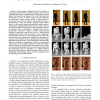94 search results - page 4 / 19 » Impact of Dynamic Model Learning on Classification of Human ... |
LREC
2010
13 years 7 months ago
2010
In the paper we investigate the impact of data size on a Word Sense Disambiguation task (WSD). We question the assumption that the knowledge acquisition bottleneck, which is known...
CVPR
2006
IEEE
14 years 8 months ago
2006
IEEE
Dynamic appearance is one of the most important cues for tracking and identifying moving people. However, direct modeling spatio-temporal variations of such appearance is often a ...
IROS
2009
IEEE
14 years 21 days ago
2009
IEEE
— Programming a humanoid robot to perform an action that takes the robot’s complex dynamics into account is a challenging problem. Traditional approaches typically require high...
CRV
2008
IEEE
14 years 15 days ago
2008
IEEE
We propose a generative statistical approach to human motion modeling and tracking that utilizes probabilistic latent semantic (PLSA) models to describe the mapping of image featu...
ECCV
2010
Springer
13 years 9 months ago
2010
Springer
Abstract. Much recent research in human activity recognition has focused on the problem of recognizing simple repetitive (walking, running, waving) and punctual actions (sitting up...

